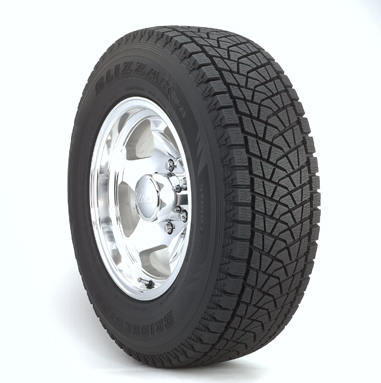By JILL ADLER
Studded snow tires have long been a staple in my home state of Utah. In other places, where you go off to the mountains once a week at the most, you carry chains, torture yourself on the side of the road in whipping wind and finger-freezing snow while you try to wrap those clunky links around your tires.
Another option, all-season tires work fine in many conditions but they master none. When I tried to ride all-season tires out my first winter in Utah, they sucked, to put it bluntly, slipping and flailing wherever the snow stuck to the road.
If you anticipate driving in snow 20 days or more a year, I suggest you invest in good snow tires. Mountainfolk get studs in November and remove them in April. The tires are good for three seasons, salesmen say, but honestly the studs start to wear the minute you drive off the tire lot, and you definitely notice the traction decrease from month to month.

Blizzak DM-Z3 Snow Tires
When I heard about the Bridgestone Blizzak DM-Z3s — a non-studded snow tire alternative — I had to have them. The tread wears longer than most studs, and there’s no state law mandating I change out my tires like there is with studded ones (March 31 in Utah). I do change them out but only to preserve their tread, not because I’m afraid of a $145 ticket (o.k., I am but that’s not the point).
I’ve heard the sales pitch a zillion times — all-wheel-drive and four-wheel-drive cars are only as good as their tires. Like an Olympic marathoner or a world-champion skier, the salesman said, it comes down to what touches the ground. I didn’t believe it (I thought it was just a pitch) until I installed the Blizzaks. With something called UNI-T technology, the rubber grips like a competitive trail runner. My first attempt up the 30-degree, snow-covered incline with my Hyundai Santa Fe all-wheel-drive had me at ‘Hello.’
The tire’s ($102 – $135 per tire, depending on your tire size; www.bridgestone-firestone.com) design and rounder shape improves handling in wet or dry conditions, reduces irregular treadwear, and provides better balance for wet or dry handling. The tread is designed to bite through the first layer of snow and slush, and the compounds in the rubber keep the tread pliable and grippy even when the temps plunge. I couldn’t believe that they would work the same as my studded tires, let alone better, but they did! Even after three seasons with them, I’m still roaring up my driveway while my roomies are stuck at the bottom forced to shovel snow if they don’t want to park in the street.
The biggest drawback to buying a set of Blizzaks is the price — a set installed will run more than $500. Someone had to tell me to breathe when I saw the sticker. Not only are you plunking down a lot of money for tires that will last you only about 20 months, but you will also pay $80 to $160 per year to change them out with your summer tires if you don’t put them on their own set of wheels. Either you need to be rich or lazy or both to purchase Blizzaks. I’m lazy. (Wish I were rich!)
But I’ve never gotten the hang of putting on chains nor did I want to pay a plow service to manage my driveway. The easy alternative was to get these burly tires that laughed in the face of twisting mountain roads and my driveway’s steep concrete slope. It was one of the best winter decisions I have ever made.
—Based in Park City, Utah, Jill Adler covers skiing, adventure sports, hiking, and adventure travel for online and print publications including Sunset, SkiPress, and Salt Lake magazines, FuelTV, MSN.com, and she is the associate editor for OnTheSnow.com. She is also a broadcaster, actor, and a Level III certified ski instructor.








